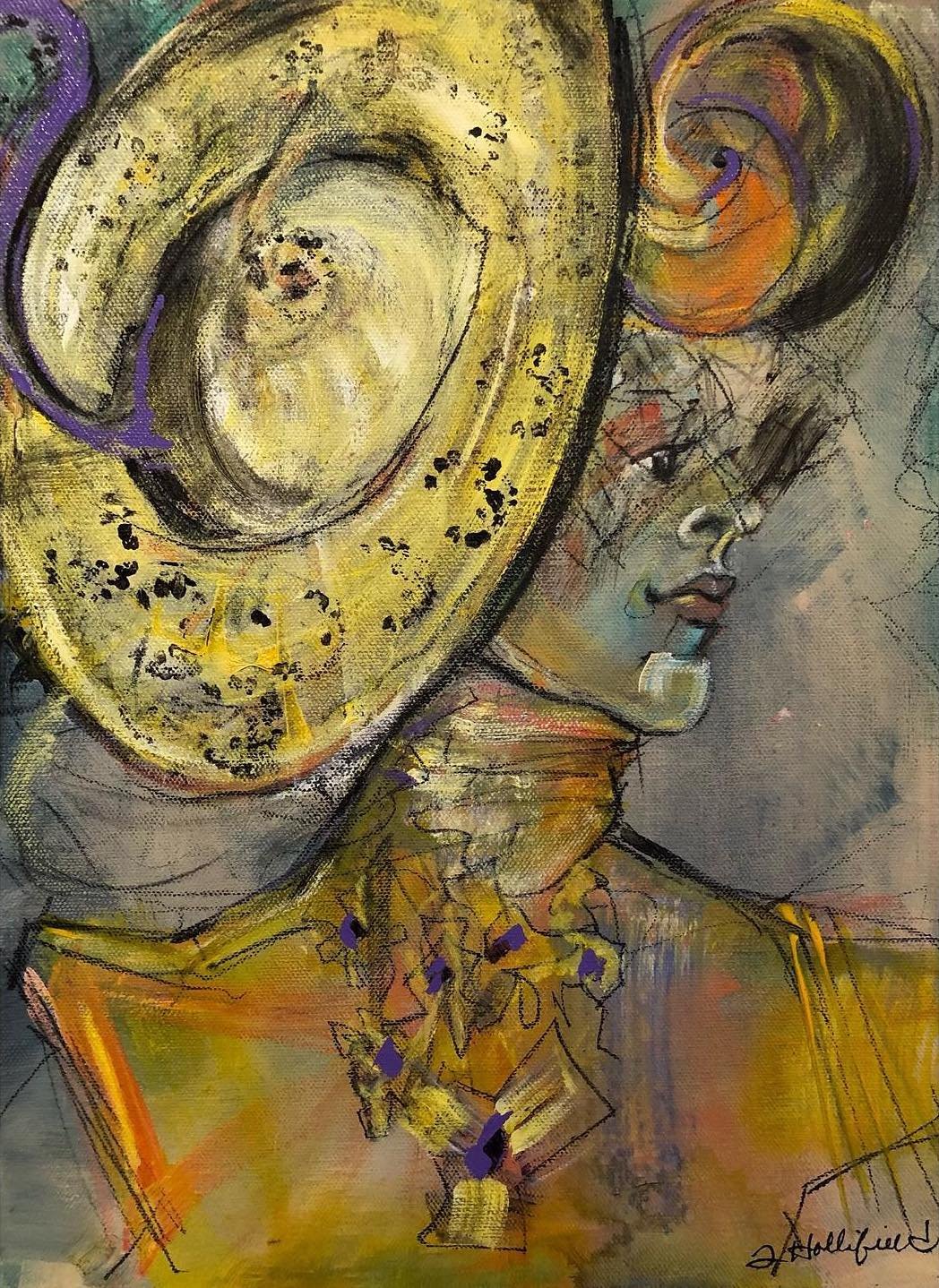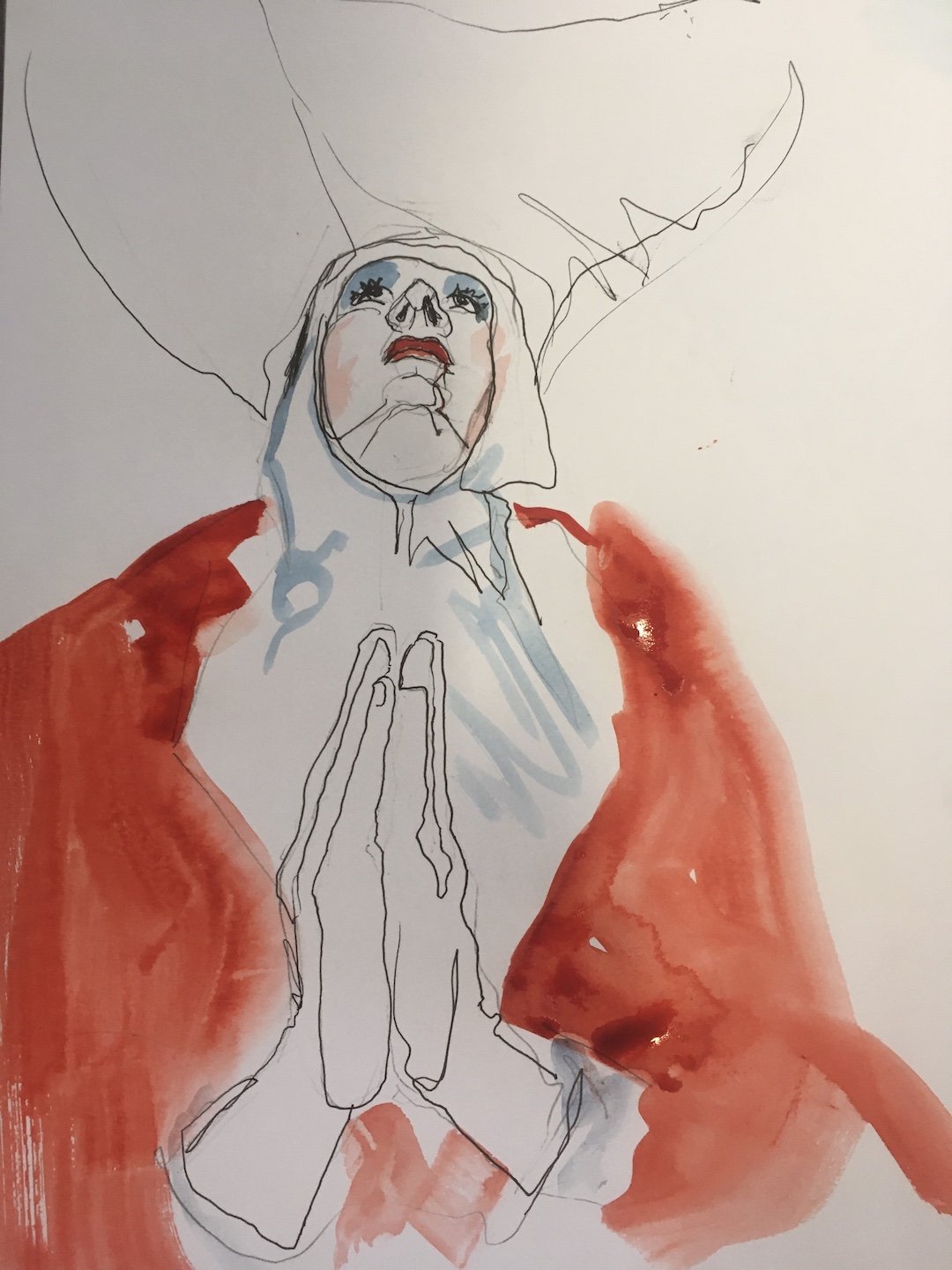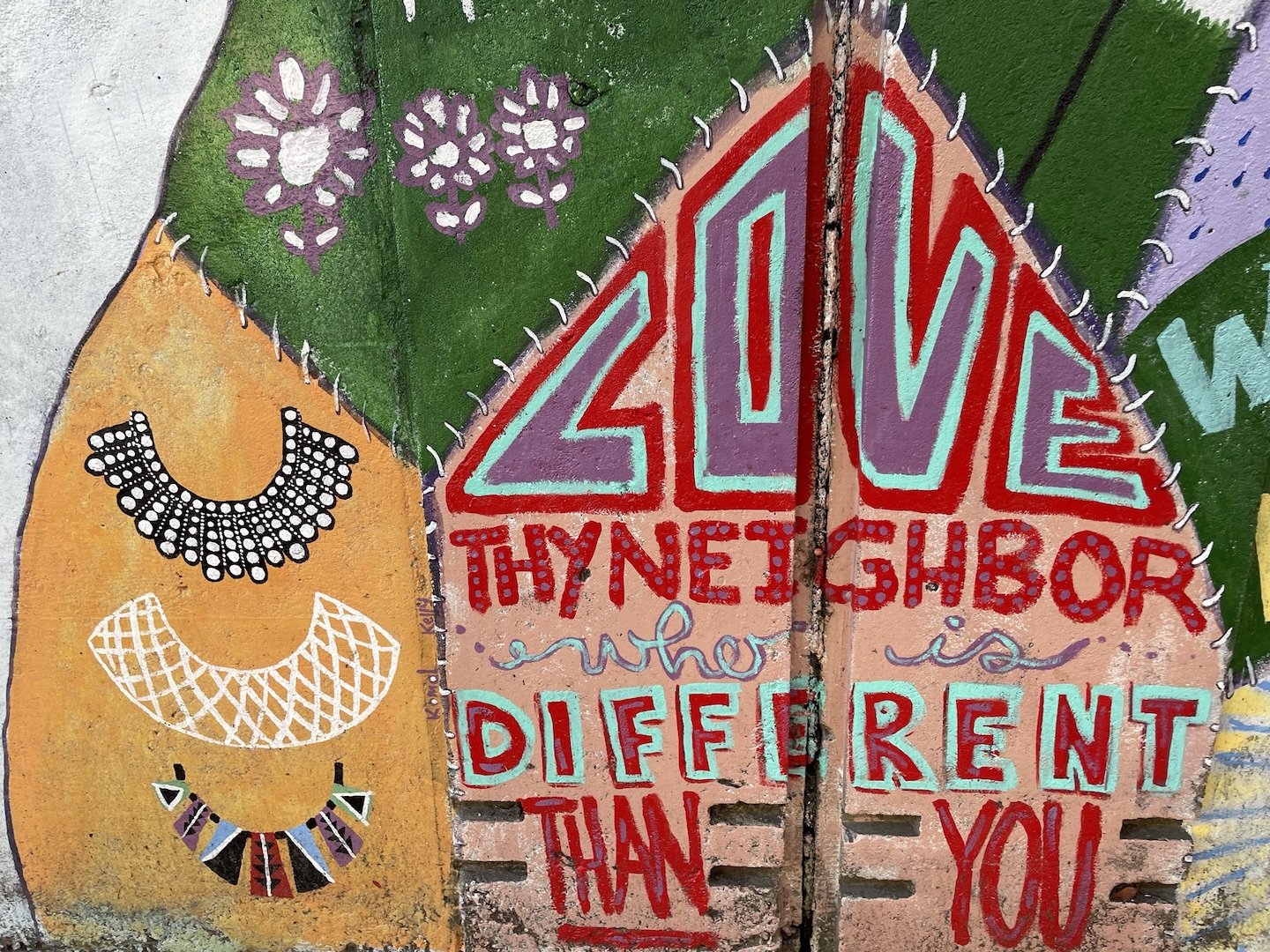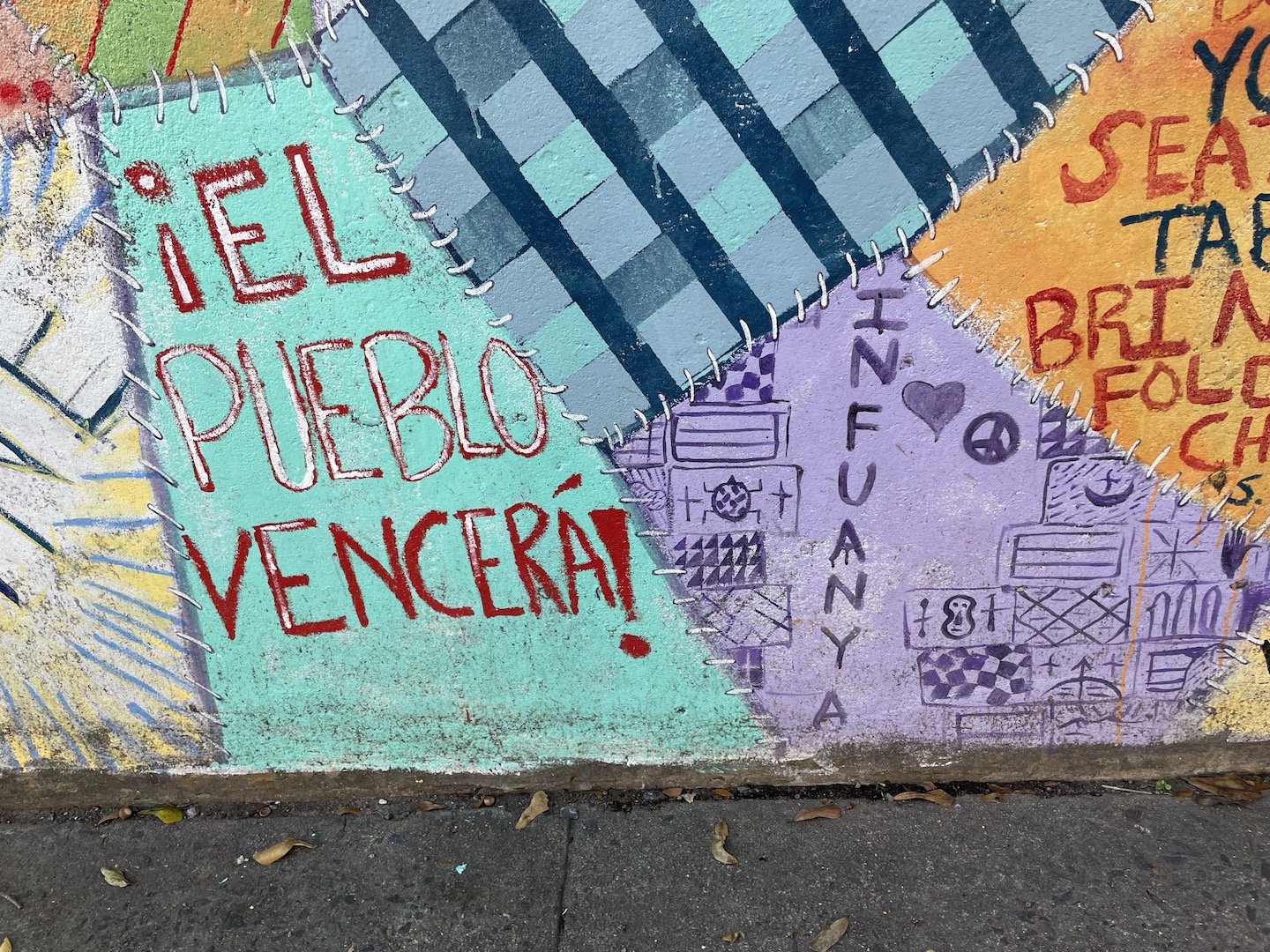Interview with artist Tanya Hollifield
Tanya Hollifield is an artist living and working in Little Rock. For Tanya, creating art and using art to benefit others is a spiritual process to better understand herself. Her murals, especially, have touched many in the community and are an important outlet for her advocacy for others. Tanya’s paintings are colorful interpretations of the human spirit. More of her work can be found at M2 Gallery in Little Rock.




AAS: Tanya, would you talk about your background and art education? Did you grow up in Arkansas?
TH: My early exposure to art was when I was a toddler in San Francisco in the early 60’s. My mother was in art school, and we did art together. Living the 60’s hippy life, my mom took us to Taos, New Mexico where we lived in an adobe two-room house with dirt floor and outhouse. I loved that time in life. However, an unfortunate incident interrupted life and made it so my mom could not take care of me anymore. So, just before I began school my grandparents took me to the small rural town of Amity, Arkansas. Sadly, there was no art education, galleries or museums for me for the next 12 years of my life, but I knew that art was the only thing I ever excelled at. So, I went to college and began my career as a commercial artist, mainly production art. In the mid 90’s I began to get back to fine art. I sculpted with clay and mixed media for several years, along with some painting. I did self-study at the Arkansas Arts Center (now the AMFA), the Art Students League of New York City and independent study at the University of Arkansas, Little Rock. I look forward to continuing to learn, hopefully with some travel art-learning experiences in the near future.
AAS: You’ve said you are reinventing yourself and your art. What do you mean by that?
TH: After abandoning the practice of art for a few years, I came back to art as an immensely changed person. I had become an activist for criminal justice reform and other causes. So, I knew I couldn’t just take back up where I left off. I knew my art would have to reflect that. But my drawing and painting skills were rusty. It was frustrating not to have the loose and energetic line quality I had. In the beginning it was too forced and overthought. After not drawing or painting for several years I had to retrain myself. In a way it was harder re-honing my skills than beginning from scratch because the preconceived notions of what I used to do were getting in the way. I also knew I wanted some social or environmental justice themes in my art. I have found a satisfying balance between advocacy art and the art that is more spontaneous and playful.
AAS: The last couple of years have been very busy for you. I would like to first talk about your recent Water Is Life mural. It is spectacular!
TH: This was different from my other public art pieces because it was a collaboration between me and the US Water Alliance and Central Arkansas Water. It was part of the Accelerator program, funded by the US Water Alliance to engage the public with addressing water issues and climate change. The idea behind the partnership with CAW and the community was to involve the community in the process. In the end, around 70 people had a hand in creating the mural.
Here in Little Rock, Arkansas our water utility provides us with some of the best water in the nation. So I asked CAW if we could get a water bottle filler in the mural, giving 24/7 water access to people on the streets. Sharing and celebrating our good water. They loved the idea, so that feature is what the mural was designed around. It also gives the art a function. I like it when art is functional.
Volunteers from the Clinton School of PUblic Service working on the Water Is Life mural.
As for the design elements, the design changed and elements were added along the way. Not the way most murals come to be. This one was not fully realized when we started painting. We started with the phrase Forest to Faucet, which is the project name. I drew stylized trees to border the top and stylized water to border the bottom and had volunteers from the Clinton School of Public Service come and paint a kind of paint by numbers. It was stressful being the artist and not having the design already on paper, but it grew and came together perfectly. I brought in the stencil images representing things you need water for. In this way we were able to engage more people in the process. The words Water is Life and the image of a local person, Derek Brooks, holding out the water, actually came fairly late in the design. Once I set on adding the words in bright sunset orange colors, and the image of a person, I knew I wanted the person to be someone that the community knew and could connect with. This was a pilot program and there was a lot of experimentation and meetings and interviews with various groups and individuals added to the art and design. I had done a lot of social justice art, and really was honored to get to also do some environmental justice public art. I am still in talks with Central Arkansas Water about other places to do public art.
Water Is Life mural at 301 East Capitol, Little Rock, Arkansas
AAS: You have been very involved in the 7th Street Mural Project and I’ve interviewed several artists who have contributed to it. Talk about the work you have done and what the project means to the artists and community.
TH: I first got involved with the Peace Week murals on 7th Street through the Arkansas Coalition for Peace and Justice annual community painting events in 2016 and have had a role in the murals ever since. The real growth happened in 2020, after the George Floyd incident sparked national activism. The 7th street corridor grew organically with the lead of some of the graffiti artists painting George Floyd’s portrait on a section of the wall. The seeds planted by the ACPJ grew on its own with artists from all walks of life coming down and putting their messages of peace and justice on the walls. It was an extremely special thing to be a part of, to watch the community come down and be a part of it. It is really hard to explain the feeling of this time, a true grassroots art as activism happening that spanned a quarter of a mile of walls under the railroad tracks. These murals belong to the community and it shows. People gather to take graduation photos, music videos, family outings, etc.
Patchwork Peace and Protest, 7th Street Mural Project, Little Rock, Arkansas
Working on 7th street with artists from so many practices was a most wonderful experience. We were all so different, but the messages of peace and social justice carried a common thread. We bonded. We did not always agree, but the message was bigger than any one of us.
I came up with the Patchwork Peace and Protest mural idea for 2020 Peace Week featuring local activist Crystal Mercer, who is a textile artist and poet herself. I think the theme that year was something like Piecing Peace Together, so hence the quilt sewn together with messages from 33 people who painted on the quilt sections. There are many viewpoints, as well as different languages on the mural, including Spanish and Igbo. I am currently working on one with several other women including Melissa Gill and others. “Women Belong In All Places Where Decisions Are Being Made” will shine light on various female social justice warriors.



AAS: I saw some of your paintings at the She Exhibition at M2 Gallery in September and was just blown away by your Cabaret Couture Series. Would you talk about that series and Lemon Lemon?
Lemon Lemon, 17” x 14”, acrylic and felt tip on paper
TH: The Drawing Cabaret Couture sessions are presented by a duo in the UK and I credit them with helping me break through a drawing barrier. My line work began to become looser and freer. I always get pulled into these worlds they create through staging, soundtracks and high-end and often avant garde fashion. These two drawings were from a couple of my favorite sessions. Lemon, Lemon pulled influences from ‘The Vivian Girls’ inspired by artist Henry Darger who saw the world through very naive, childlike eyes. Prior to the session I watched the documentary about this man and his art. I think I captured a childlike innocence with the soft colors and delicate lines.
Circus of One, 14” x 17”, watercolor, pastel, felt tip on paper
As for Circus of One it was one of the first DCC sessions I participated in as I recall. It was so exciting; I find everything about circuses and puppets fascinating. In this session called Haute Hanger, the model, Janet, modeled hanging from ropes. It was like she was a human puppet. It was very fast paced, attempting to get the action, costume and pose captured in 10 minutes or so. There was not time to think, which is why it works so well. That is when the art becomes pure and that sense of playfulness shows in the strokes.
AAS: In October you had a show at ACANSA titled Janet. Would you talk about that show and a terrific piece, 8 Cents Love?
8 Cents Love, 13” x 10.5”, acrylic, felt tip, charcoal and collage on paper
TH: This show was a story about both finding new inspiration during a time of isolation and my obsession with one particular muse for 52+ weeks, Janet. I drew many a character that she became through the drawing sessions produced by Drawing Cabaret Couture. The dynamic duo of Janet Mayer (model and cabaret dancer) and partner Matthew Lawrence (stage designer and camera man) have brought the designs of many famous and emerging fashion designers forward. Their extensive staging and inspiring soundtracks drew artists from around the world into another world through each zoom session.
The piece 8 Cents Love was first drawn in a DCC session with a 70’s theme. But it was unfinished. I worked on it later to add to the story and make it my own. The stamps were some I have had in a box since the 70’s when I was young. I never knew why I saved them, but this was the time to use them. I was transported back to my youth in the making of this piece. It definitely has a pop vintage air about it.
AAS: One of your pieces that I think has so much wonderful emotion is Story of Agar Agar. What is it about?
Story of Agar Agar, 17” x 14”, acrylic, charcoal, collage on paper
TH: In contrast to most of the pure drawings I created during quarantine and social distancing, this was a product of the ending of quarantine. So, several of my mixed media pieces were finished in a group setting in Diane Harper’s studio when the quarantine was ended and we gradually began to socialize again, “The Story of Agar Agar” was one of those. I was energized working among other artists and was able to finish this piece with some collage from an old LIFE magazine page of “The Story of Agar Agar”. The drawing session had hats by Edwina Ibbotson that had that antiquated feel. This LIFE magazine page fit the essence of the picture. I hope that people can look at it, as with other pieces, and make the story their own.
AAS: Another one I really like is Beauty Is A Nectar. The woman dressed over-the-top like some kind of a flower and the bees coming in – what is the story behind that piece?
Beauty Is A Nectar, 36” x 24”, acrylic and charcoal on canvas
TH: Here I am trying something new on canvas. The lady was a pastel drawing from one of the earlier sessions I did with DCC. I really liked the drawing and I knew I wanted it larger and on canvas. The dress was of a lot of vibrant colored tulle and it did seem kind of like a flower. Here I added bees to the story that were not part of the original sketch. I was inspired by the artist Rebecca Suzanne Haines to bring some animals into my art. She paints rather abstracted colorful wildlife creatures she calls friends so I felt the bees gave this beautiful creature dressed in colorful tulle some friends.
I became acquainted with Rebecca’s art and many other artists who are currently influencing my art from a Facebook group called The Heart of Drawing. As a matter of fact I am being published in the Heart of Drawing Book with artists from around the world at this moment.
AAS: A few years ago, you helped put together a very acclaimed exhibition called the Portrait Prison Project. One of your pieces Ponder A Life Changed is a powerful work. Talk about the Project and your portrait.
Ponder A Life Changed, 24” x 20”, acrylic, charcoal, conte crayon and collage on canvas
TH: This was a perfect project for me, combining my advocacy for criminal justice reform and getting to bring together a bunch of artists for the show. I was invited by Morgan Leyenberger, the director of Compassion Works for All at the time, to help her and Ellie Wheeler make their vision of this activist art show come to life. I helped them reach out to get local artists to participate. We had 25 artists do artwork to tell the stories of the incarcerated participants. We had 2 or more artists creating portraits per participant, each having very diverse styles, so some portraits were traditional and some more conceptual or stylized. The show was a great success. The show did help raise awareness of the work Compassion Works For All does by taking meditation into the prisons to help free the minds of those incarcerated. We also raised some funds through the show so they could continue their work.
I did one of the portraits of John Ponder. I tried to honor the story he provided. I did not try to judge why he might be there. I thought “Can people recreate themselves behind those concrete walls and wire fences?” The answer was a resounding yes. John was sentenced to life at the young age of 14. He said “I came of age, matured as a man in prison…”. So, I wanted to show the light of the human spirit breaking out of the bleak concrete walls of the prison. The bird in the image is collaged onto the canvas of a bird he had drawn. I wanted to tell the story of how art frees the mind and soul of those locked away. The marks on the wall represent the years he has been in jail. He saw the newspaper story about the show and wrote me via the gallery. John was amazed at how well I communicated his situation.
Compassion Works For All takes meditation practices into the prisons. They have helped many an individual survive the inhumane conditions of prison and solitary confinement. Some have later re-entered society successfully in part due to this organization. Using my art as a social or environmental tool makes it seem worthy. We do plan to do another one with CWFA in the near future.
AAS: Tanya, you seem to enjoy working out in public and with the public. What have you learned about yourself through all of this and what is next for you?
TH: I am an extrovert. That does not always work for an artist, because long, lone hours in a studio are part of the practice. When I get to work with people it energizes me and feeds my soul. Working with the public to create public art is special in that the art belongs to the community. Being a part of something larger than myself or my own work can’t be put into words. I have to find opportunities to work with people to keep myself from becoming stale. I do have some ideas not yet formulated that I hope will keep me working with others and making art outside the studio.



